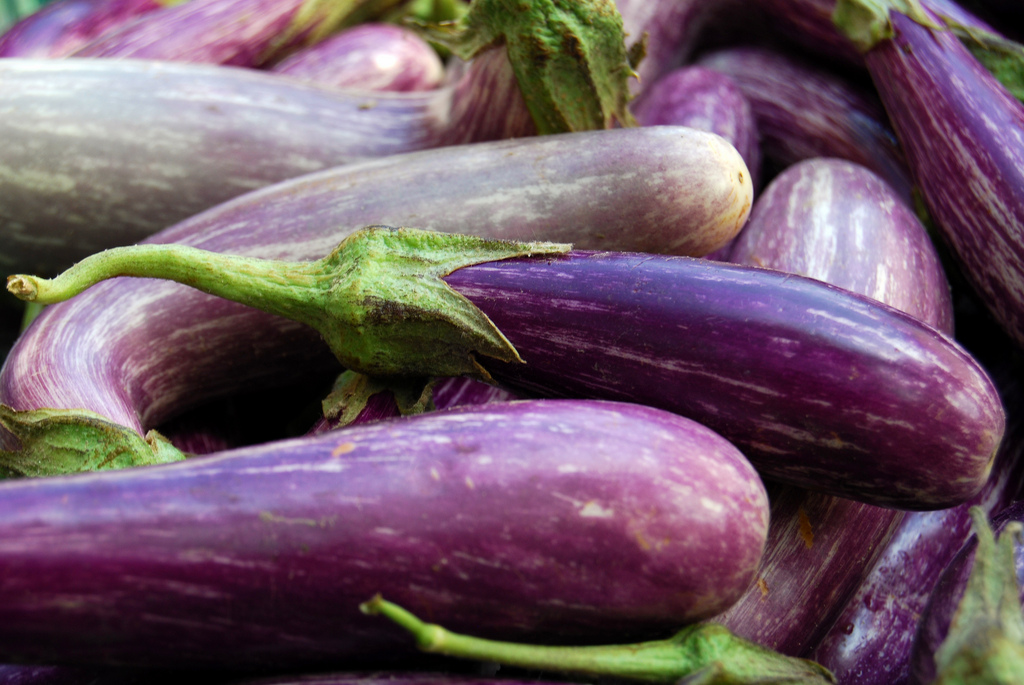As a result of its versatility, eggplant found a welcome home in Israel during the austerity after the 1948 War of Independence. During the country’s early years, chicken was a rarity, beef unavailable and eggs handed out one by one. Eggplant was one of the easily obtainable, unrationed foods, so cooks improvised to vary their scarce diet. “In the 1950s, there was no meat and no money to buy meat,” says Dalia Lamdani, a retired editor of La’Isha Magazine. “It was a time of substitutions,” adds Lamdani. “Eggplant was cheap and we had a lot of it. One thing that became very popular was chopped liver made of eggplant. Later, people wanted to forget the food of the bad times and it more or less disappeared.”
Today, eggplant is enjoying a resurgence. No mezze and practically no meal in Israel is complete without at least one eggplant salad. Popular roasted dishes include baba ghanouj, a combination of the pulp of the roasted eggplant, tahina (sesame seed paste) and lemon juice that literally means “spoiled father,” probably because it tastes so good that the father to whom it is served is spoiled by the flavors. Salat chatzilim, which means eggplant salad in Hebrew, is also made from the pulp of grilled eggplant, which I once was served with Worcestershire sauce.
Eggplant also has greeted me in Tbilisi, Georgia. There, at a Sabbath dinner in a Jewish home, I tasted a marvelous appetizer called “eggplant bits” made from diced pieces of eggplant pulp and black skin sprinkled with aromatic toasted spices. When I mentioned this dish to cookbook author Paula Wolfert, who spent a great deal of time searching out recipes in Tbilisi, she told me that she had never heard of it and concluded that it must be unique to the Jewish community. Then, last year, I interviewed the late Serena Modigliani, a political activist and avid gardener who fled fascist Italy with her husband, the future MIT economics professor and Nobel Laureate Franco Modigliani. When I asked her for some family recipes, she told me of her favorite dish of fried bits of eggplant—the same recipe I’d tasted in Tbilisi but without spices. Eventually, these eggplant bits, salted to remove the water for frying, were mixed with more onions, tomatoes, olives and raisins and transformed into a Sicilian dish, eggplant caponata. It’s often called melanzana alla giudea—Jewish-style eggplant.
A quotidian food for many, eggplant also exists in the sacred spaces of Judaism. Each Sabbath, a Moroccan friend makes two types of eggplant as part of the mezze which begins the Sabbath feast—one roasted where the pulp is used like a dip and another sautéed, often mixed with tomatoes and other vegetables. For her, these dishes are a symbol of the Kadosh, or holiness of Sabbath. For me as well, eggplant is more than a food. It represents life and its journeys.
Melanzana alia Giudea (Serena Modigliani’s Jewish-style Eggplant Bits)
2 pounds eggplant, unpeeled
1 tablespoon salt (about)
2 garlic cloves, minced
4 scallions, chopped
1/4 cup olive oil
Freshly ground pepper to taste
2 tablespoons chopped parsley
1 handful pomegranate seeds (optional)
Note: The Georgian version includes 1 teaspoon of coriander, cumin, fenugreek and cayenne pepper.
1. Slice eggplants into 2-inch by 1-inch by 1/2-inch slices. Sprinkle with salt and let sit in a colander over a bowl for 30 minutes. Wash off salt and drain.
2. Saute garlic cloves and scallions with eggplant bits in olive oil, stirring occasionally, for about 20 minutes or until eggplant is chewy and slightly crisp. Drain on paper towels.
3. Sprinkle with spice combination (for the Georgian version) and salt and pepper to taste. Before serving, sprinkle with parsley and, if you like, with pomegranate seeds.
Yield: 6 servings as an appetizer


The family loves eggplant, but I’m only recently acquiring the taste. Credit goes to my husband who lovingly and dedicatedly has begun gardening and growing these in plenty. I love admiring the colour change and the deep hue once mature. Deep Purple!